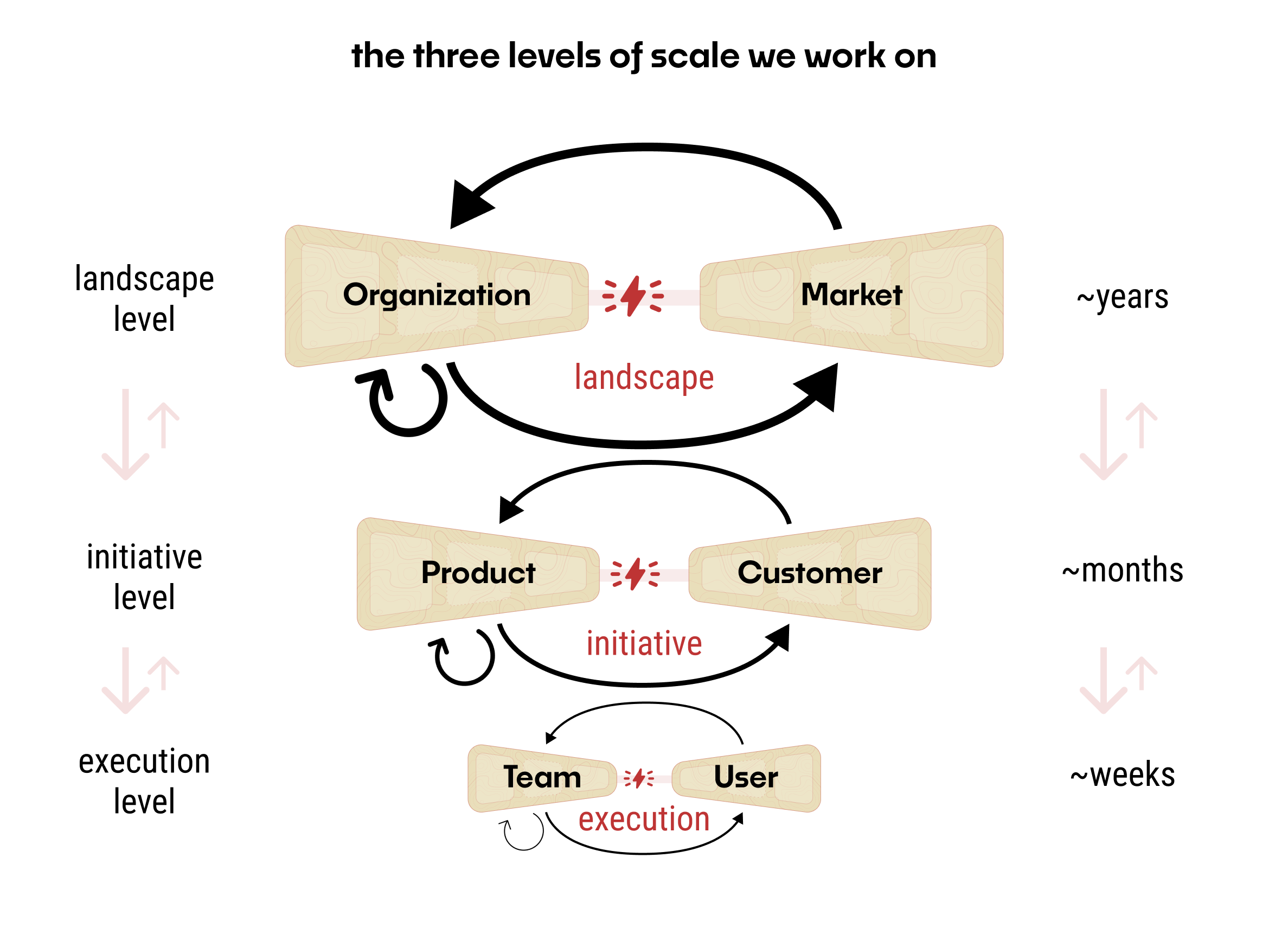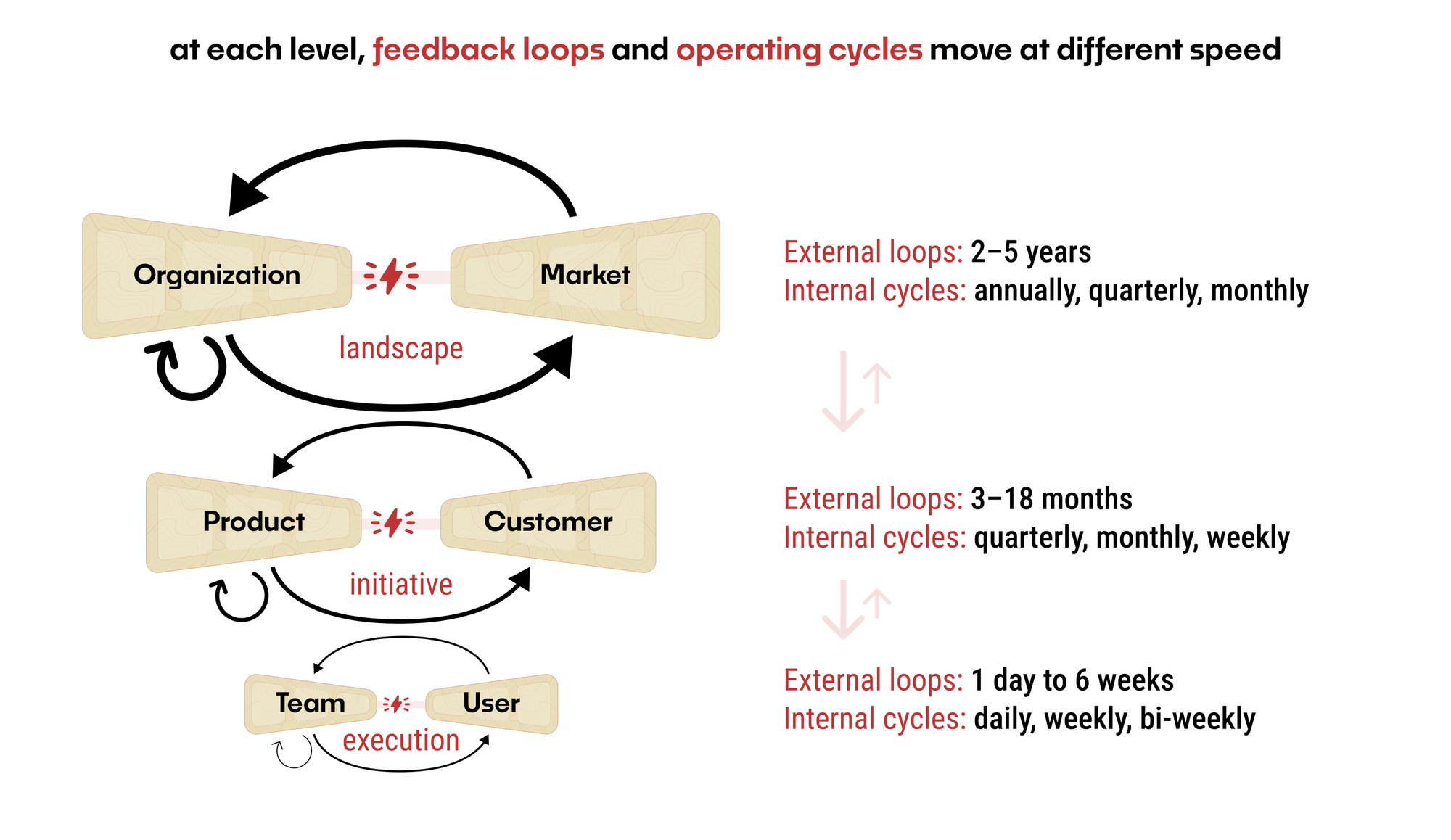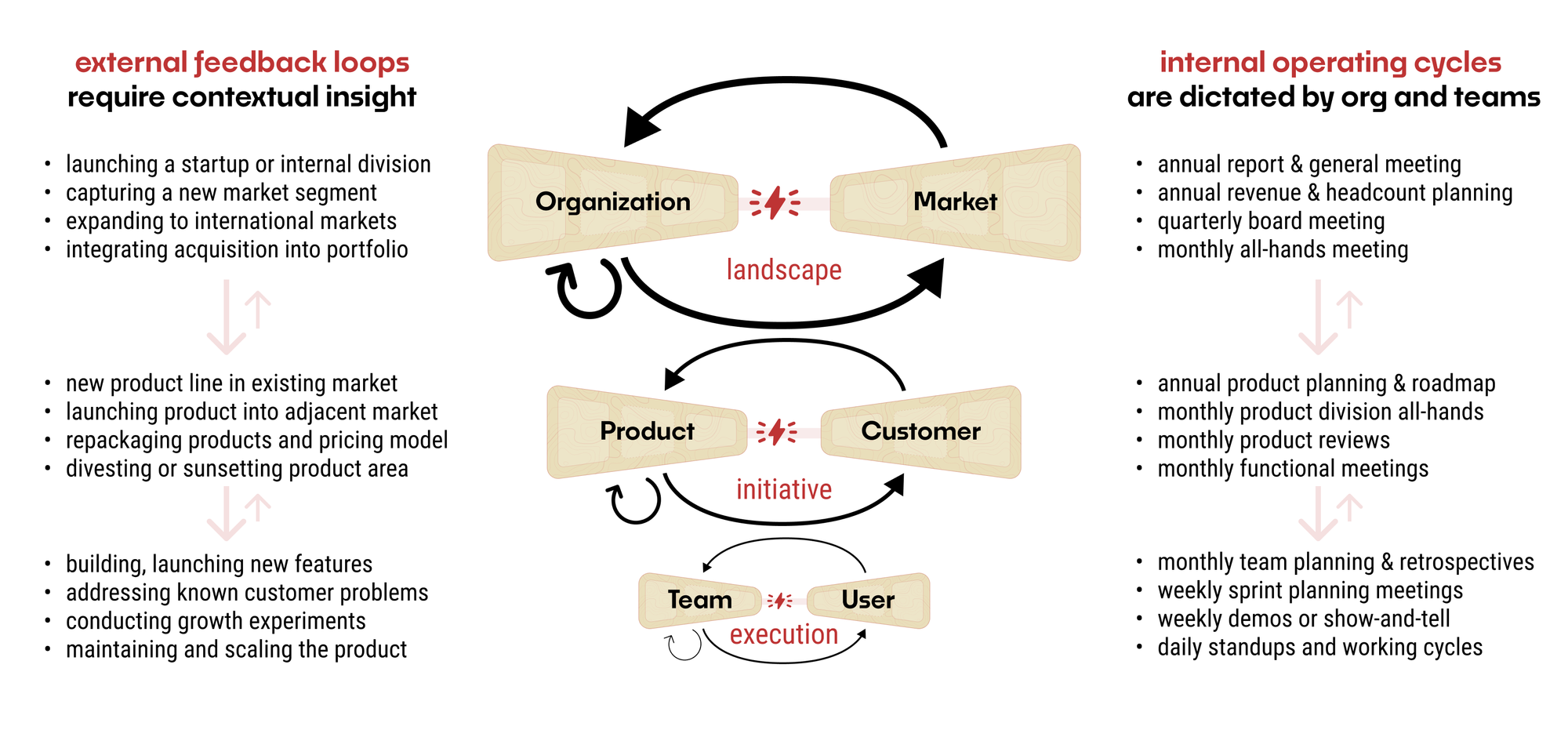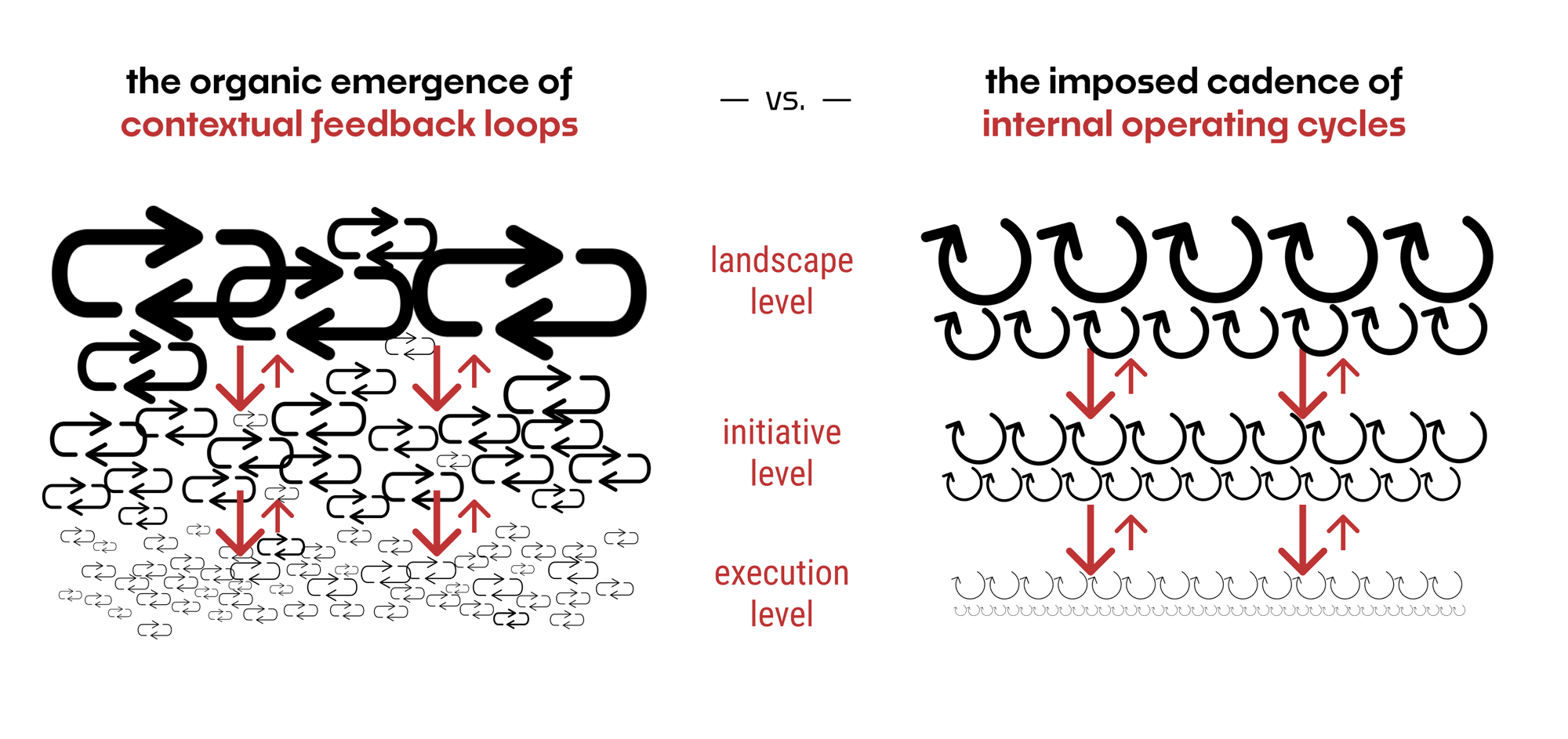Research in its current incarnation is valuable because so many external feedback loops that need to be "closed" require qualitative human insight — insight into behavior, activities, expectations, goals, experience, and context — and the capacity to interpret and reframe that information to set the team in a productive direction.
For a research program to be successful, though, doing that alone is not good enough. That's core; but the core doesn't sell itself. There is an entirely different class of cycle driven by internal organizational constraints that a research program must integrate with to drive change and impact.
Today, with an eye towards organizational fluency, we'll peel apart three levels of organizational scale, and then examine the crucial difference between external feedback loops, and internal operating cycles that operate on those different levels of scale.
Our activities live across three levels of scale
There are many ways to slice our practice and the organizational context it sits in. The simplest divide is to speak about "strategic" vs. "tactical". With more nuance, Judd Antin defines research activities in terms of macro, middle, and micro-level work: this view speaks particularly well to the nature of research that best suits each level.
For our purposes here, our view will zoom out one level higher than research itself, using the scales of landscape, initiative, and execution. These levels are inspired by the intersection of the structural view of experience and different perspectives present in the organization.

The key aspects of these three levels are the scope of influence that given decisions might take, an associated perspective, and a corresponding time cycle to make those decisions and receive external signals about their suitability.
- Landscape:
- Activities here relate to charting market trajectory, identify current and future value in the landscape; deciding where and how to play there.
- The dominant perspective is business.
- The prevailing timescale is years.
- Initiative:
- Activities here tend to focus on specific products and relate to identifying user needs, capturing additional and adjacent with product capabilities; targeting specific customer workflows; and product packaging and pricing.
- The dominant perspective is product.
- The prevailing timescale is months.
- Execution:
- Activities here tend to focus on iterative delivery; new features; risk and hypothesis testing; product maintenance and scale work.
- The dominant perspectives are design and product.
- The prevailing timescale is weeks.
This distinction is important for us because the need for research — contextual insight — is dramatically more frequent at lower scales, and remarkably less frequent at higher scales.
"Natural" loops and "fabricated" cycles
At each level of scale, two kinds of loops arise: external feedback loops, and internal operating cycles. Both exist because the organization exists, and we pay attention to them quite differently.
Individual researchers are professionals who work with external feedback loops. Research programs must become experts at working with internal operating cycles.

External feedback loops drive the need for research
External feedback loops arise because the organization changes, and its context changes, and there are natural rhythms of "sense and respond" that must occur to avoid drifting into disaster. A new product launch is a contextual feedback loop, as is a design system overhaul, as is a growth experiment.
External feedback loops are oddly shaped, organic, not entirely predictable, and create the need for research. Some come about because the organization attempts to do something new, or changes to the existing product. Some come about because the organization gets new information or signals it was not aware of before. And some come about because of the inevitable evolution of the market: changes in technology, competition, user behavior, and economic conditions.
In a successful organization, one external feedback loop begets another. Any successful change or response to the internal-external coupling changes the state of the larger system. And new loops arise. Understanding these loops is how to understand the demand for user research in the organization.
Internal operating cycles drive change and impact
The second, internal operating cycles, emerge from the organization and its internal constraints. These are cadences imposed on the organization because it exists, and are not related the external contexts (market, customer, user) the organization is serving. A quarterly board meeting is an internal operating cycle, and a monthly all-hands, a weekly sprint kickoff, and a daily standup are internal cycles, too.
Internal operating cycles are predictable: they are usually scheduled well in advance, and are often cadences and repeating rituals. They are the places of ensuring shared understanding, tracking progress, clarifying goals, and coordinating work. Each already has organizational goals that must be respected, and each cycle is an existing structure that should understood, and potentially attended to.
For a research program, they are an overlooked point of integration at each level of scale. Depending on the scope of research and the external feedback loops it originates from, there are corresponding internal operating cycles that it must hook into. In a successful organization, these loops have their own internal feedback mechanisms and are open to experimentation, introduction of new content, and shared learning.
To solve for loops, integrate with cycles
One factor in the success of Teresa Torres' continuous discovery framing is its inherently organizational perspective: it respects first and foremost the cadence of internal operating cycles that teams use as their standard operating model. It then offers the tools to help them work through external feedback loops at their existing cadences.

As a concrete example, to manage the external feedback loops of "building and launching new features" and "maintaining and scaling the product," continuous discovery habits were designed first and foremost to integrate with product teams' internal operating cycles of "weekly sprint planning meetings," "weekly demos or show-and-tell," and "daily standups and working cycles."
The same opportunity to align our external work with internal cycles is open to research teams, despite some inertia. One historical research perspective is entirely the opposite: this kind of work takes time and product teams don't understand! That's true, and it's also willfully disregarding the realities and rhythms of crucial partners — the very people who are ostensibly the partners to and end-users of our work.
I won't argue that a research program should try to participate in or integrate with every cycle on the internal side. I do believe that any strategic approach to a research program will recognize those key activities and rituals that are crucial to achieving the team's larger goals, and plan out how best participate in them, refine them, and ultimately adapt them for the better. For a successful program, and a successful researcher at higher levels of influence, organizational fluency is core to impact.
The organization is the sum of its loops and cycles
We like to speak about "understanding the business" as a precursor to being influential in the organization. That conversation often begins with the business model, and it's been a decade since Jared Spool gave his UX Strategy Means Business talk. All too often, it ends there.
An organization is a thrumming hive of activities and ideas, with natural cadences and structural rhythms designed for administrative oversight and legibility, shared understanding and alignment, clarity of communication, and cross-functional collaboration. It's loops and cycles all the way down.

Any program that does not respect and work to improve the organization's existing operating cycles, or at least understand them, should not expect to be seen as a partner to its larger scope of work.
If our goal is integration into the organization, to push our practices to the next level, we cannot afford to ignore the internal operating cycles at the expense of the contextual feedback loops we already work with so well.
This essay is part of my larger exploration into the evolution of research and its integration with product practices in the organization.
For behind-the-scenes updates, contextual commentary, and personal prognostication, try my newsletter.



